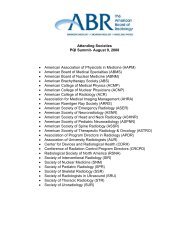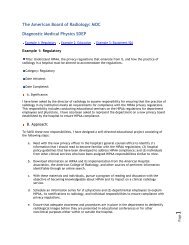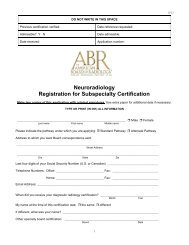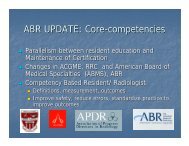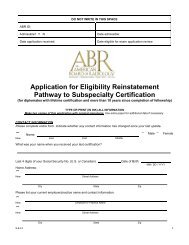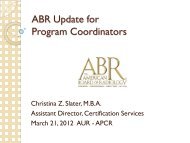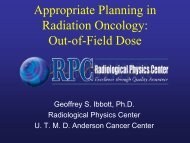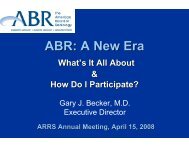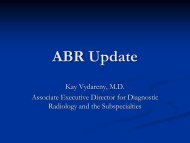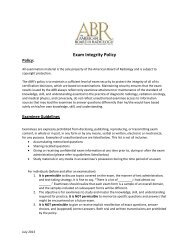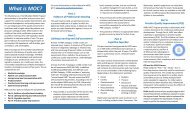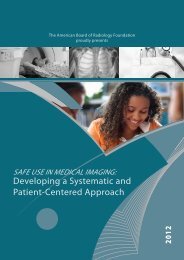Maintaining the Public Trust - The American Board of Radiology
Maintaining the Public Trust - The American Board of Radiology
Maintaining the Public Trust - The American Board of Radiology
Create successful ePaper yourself
Turn your PDF publications into a flip-book with our unique Google optimized e-Paper software.
Throughout <strong>the</strong> year, consideringall oral and computer-based examsin all locations, <strong>the</strong> ABR administers44 different types <strong>of</strong> exams.Ano<strong>the</strong>r key effort under way in training and initialcertification is <strong>the</strong> Milestones Project, a joint effort<strong>of</strong> <strong>the</strong> Accreditation Council for Graduate MedicalEducation (ACGME) and each <strong>of</strong> <strong>the</strong> specialty boards.<strong>The</strong> goal is to determine a list <strong>of</strong> key milestones in trainingthat each resident must achieve at specified timepoints to be considered ready for independent practice.<strong>The</strong> Diagnostic <strong>Radiology</strong> Milestones Working Group,chaired by Kay Vydareny, MD, ABR associate executivedirector for diagnostic radiology and past chair <strong>of</strong><strong>the</strong> Diagnostic <strong>Radiology</strong> Residency Review Committee,had two very productive meetings in March andSeptember <strong>of</strong> 2011. <strong>The</strong> committee has written draftmilestones for each <strong>of</strong> <strong>the</strong> six ACGME competencies(medical knowledge, patient care and technical skills,pr<strong>of</strong>essionalism, interpersonal and communicationskills, systems-based practice, and practice-basedlearning and improvement) and plans to present <strong>the</strong>mfor feedback at <strong>the</strong> Association <strong>of</strong> Program Directors in<strong>Radiology</strong> (APDR) meeting in March 2012.Also in March 2011, <strong>the</strong> <strong>Board</strong> introduced a tightening<strong>of</strong> its exam security policies and communicated extensivelywith candidates, training program directors, andchairs to begin a culture change in which systematicsharing <strong>of</strong> exam content in <strong>the</strong> form <strong>of</strong> “recalls” withinand across programs will be discouraged. This effort,designed to conserve ABR resources and protect <strong>the</strong>integrity <strong>of</strong> <strong>the</strong> examinations upon which <strong>the</strong> <strong>Board</strong>bases <strong>the</strong> assurances it makes to <strong>the</strong> public about itsdiplomates, emphasizes <strong>the</strong> importance <strong>of</strong> <strong>the</strong> corecompetency <strong>of</strong> pr<strong>of</strong>essionalism.As I think about <strong>the</strong> explosion in work due to <strong>the</strong> needto build <strong>the</strong> future exams, even as we prepare anddeliver <strong>the</strong> current ones and adapt to <strong>the</strong> many changesoccurring in MOC, I am impressed that a staggeringlycomplex enterprise is thriving and moving ahead, owingto our talented, hard-working staff in <strong>Board</strong> Affairs,Certification Services (Candidate and Diplomate Services,Exam Delivery, and Exam Development), Communicationsand Editorial Serivices, Digital Imaging,Finance, Information Technology, and Psychometricsand Evaluation. More about <strong>the</strong>se areas, including initialcertification and MOC, can be found in o<strong>the</strong>r sections <strong>of</strong>this report.Aligning MOC with Practice LifeMOC poses a “chicken-or-egg” challenge. For MOCto be recognized as a key contributor to improvedhealthcare quality, safety, and affordability, boardsmust demonstrate that MOC participants deliver bettercare and outcomes than do nonparticipants, and that<strong>the</strong>y do so at a lower cost. Yet many diplomates wantto see this pro<strong>of</strong> as a precondition to participation. <strong>The</strong>obvious dilemma is that participation is required inorder to produce <strong>the</strong> data that will establish <strong>the</strong> value<strong>of</strong> MOC. Never<strong>the</strong>less, considering <strong>the</strong> best interests <strong>of</strong><strong>the</strong> public, it defies logic for detractors to argue againsta program <strong>of</strong> lifelong learning and continuous pr<strong>of</strong>essionaldevelopment, and in favor <strong>of</strong> <strong>the</strong> pre-MOC statusquo, with state medical licensure as <strong>the</strong> only ongoingrequirement.Throughout <strong>the</strong> debate and discussion about MOC,one thing has become very clear to <strong>the</strong> ABR: MOCcan succeed in delivering improved healthcare, basedon <strong>the</strong> standards we set, only if those standards areimplemented by our practicing diplomates. <strong>The</strong>refore,in addition to protecting <strong>the</strong> public, MOC must deliversufficient value to <strong>the</strong> diplomates <strong>the</strong>mselves.With this in mind, <strong>the</strong> ABR and ABMS have been workingto align MOC requirements with all o<strong>the</strong>r aspects <strong>of</strong>practice life, including o<strong>the</strong>r requirements, incentives,medical licensure, and routine workflow. Key examples(not all-inclusive) are listed below:• <strong>The</strong> Physician Quality Reporting System (PQRS) MOCProgram Incentive• Development <strong>of</strong> practice performance measures forPQRS reporting and Part IV <strong>of</strong> MOC• Alignment with Maintenance <strong>of</strong> Licensure (MOL)• Focused practice recognition within MOC• Group participation in MOC for large community andacademic practices• MOC Part IV portfolio sponsor recognition/approvalFur<strong>the</strong>r details on <strong>the</strong>se initiatives can be found in <strong>the</strong>MOC section <strong>of</strong> this report (see Page 12).5



